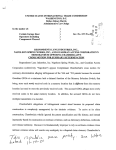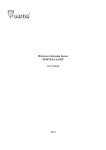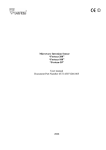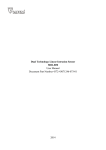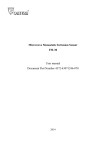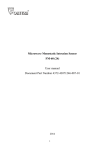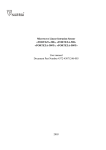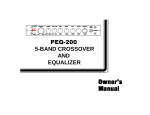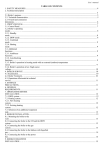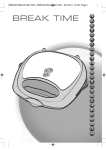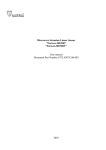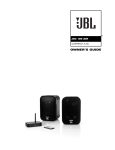Download Dual Technology Microwave Intrusion Sensors FORTEZA
Transcript
Dual Technology Microwave Intrusion Sensors FORTEZA-FONAR-COMBI User manual Document Part Number 4372-43071246-076-01 2013 1 TABLE OF CONTENTS 1. Introduction ....................................................................................................... 3 2. Purpose..................................................... ......................................................... 3 3. Specifications............................................... ..................................................... 4 4. Sensor Components ........................................................................................... 7 5. Sensor Arrangement & Operation ..................................................................... 8 5.1. Sensor Principle of Operation........ ................................................................ 8 5.2. Adjustment, Control and Indication Parts ...................................................... 10 5.3. Sensor Operation..... ....................................................................................... 12 6. Sensor Structure ................................................................................................ 13 6.1. Rx Structure .................................................................................................... 13 6.2. Tx Structure .................................................................................................... 18 7. Safety Measures ................................................................................................ 18 8. Mounting Procedure .......................................................................................... 19 8.1. Requirements for the Sector Surface and Application Conditions ................ 19 8.2. Sensor Installation .......................................................................................... 19 8.3 Sensor Connection ........................................................................................... 20 9. Sensor Setting-up Procedures and Adjustment ................................................. 26 9.1 Sensor Setup Procedure ................................................................................... 26 9.2 Sensor Adjustment .......................................................................................... 26 10. Maintenance .................................................................................................... 30 10.1 Check of Sensor Operation ........................................................................... 30 10.2 Servicing ........................................................................................................ 30 11. Troubleshooting guide ..................................................................................... 30 12. Storage ............................................................................................................. 32 13 Transportation .................................................................................................. 32 Certificate ............................................................................................................. 33 1 Delivery Kit ........................................................................................................ 33 2 Acceptance Certificate ....................................................................................... 33 3 Warranty ............................................................................................................. 34 2 1 INTRODUCTION 1.1. The present user manual contains the information about the principle of operation, structure and operating rules of the Dual Technology Microwave Intrusion Sensors FORTEZA-FONAR-COMBI (below the sensor). 1.2 The following abbreviations are used in the present document: Tx - transmitting unit Rx - receiving unit DZ - detection zone MW - microwave detection channel IR - infrared detection channel CSP - central surveillance panel RC - remote control MK - mounting kit TAK - tools and accessories kit NC - normally closed 2 PURPOSE 2.1. The sensors FORTEZA-FONAR-COMBI is a dual technology bistatic intrusion device combining two physical detection principals: microwave field and IR-ray. The sensors are mounted into park lamps. The sensors are intended to protect masked long grounds with outdoor (street) lighting function at the same time. IR and MW detection channels increase the interference immunity considerably and reduce false alarms. 2.2. The sensor is intended for continuous round-the-clock operation under the conditions of open space. It keeps operating at an ambient temperature from -40˚ to +65 С and relative humidity up to 98% at the temperature 35 С. 2.3. An alarm is transmitted by breaking the individual point relay contacts. 3 The sensor FORTEZA-FONAR-COMBI is applied with the receivers registering the breaking of executive relay contacts. 3 SPECIFICATIONS 3.1. MW and IR channels have a different form of the detection zone. An alarm is generated when an intruder crosses the detection zone of MW and IR channels at the same time. That’s why the total detection zone (the coincidence zone of MW and IR channels) coincides with the form of IR detection zone. 3.2. The detection zone dimensions of MW and IR channels are given in Table 3.1 and fig.3.1. Table 3.1 Dimensions, L, m m 10 20 30 40 50 60 75 D 0,03 0,05 0,05 0,1 0,1 0,15 0,15 b 0,5 0,8 1,1 1,3 1,6 1,8 2,0 h 1,1 1,2 1,3 1,4 1,5 1,6 1,7 L – length of the detection zone; D – diameter of IR detection zone; b – width of MW detection zone; h – height of MW detection zone. Notes. These dimensions are valid if the sensors are adjusted correctly according to item 9.2. 3.3. IR detection channel specifications: 3.3.1. Quantity of rays – 1. 3.3.2. Angle of the IR-ray divergence - 2˚. 3.3.3. Light immunity: - to sunshine - not less than 20 000 lx; - to electric illuminating equipment - not less than 1000 lx. 4 3.3.4. Sensitivity (IR-ray overlap time) - 45 ms. 3.3.5. IR-ray interference immunity – not less than 35 ms. Fig.3.1 – Detection zone 3.4. The sensors generate an alarm: when an intruder crosses the DZ at a speed of 0,1…6 m/sec at his full height and in “bent” position with probability 0,98 minimum; when there is no MW and IR signal from Tx at the same time; when there is an attempt to demount the sensor; when there is an attempt of the sabotage overlapping (sabotage radiation source); when the sensor units are out of order; when there is the remote control signal on Tx. 5 An alarm is generated by breaking the contacts of optoelectronic individual point relay (NC contacts) for 3 sec minimum. 3.5. Specifications of individual point relay (FORTEZA-FONAR-COMBI): maximum switched current is 0,01 A maximum; voltage is 50 V maximum; resistance in closed condition is 110 Ohm maximum. 3.6. The sensor is supplied from 160…240 VAC, 50 Hz mains with the possibility of connection for the sensor power supply. 3.7. The type of lighting unit - energy-saving lamp 20 W-30 W. 3.8.The sensor operation can be controlled remotely by biasing the dc voltage of 5 …30 V at the wire marked “+ДК” (RC - remote control), “-ДК” (RC - remote control) on the Tx unit. The duration of this test is 2…4 sec. Current consumption is 2 mA. The remote control is applied for all Tx channels. 3.9. A photo relay is built-in the sensors unit which permits to switch ON/OFF automatically the light according to sunset/sunrise. Also there is a possibility to control the light by hand. The control is realized along the two-wire circuit with the following specifications: isolation resistance ≥ 20 kOhm; wires resistance ≤ 2 kOhm. The two-wire circuit permits to control several units to switch ON/OFF the light simultaneously. 3.10. The sensors are immune to the influence of EMI (voltage impulses in the supply circuits, breaks of mains power supply, electrostatic discharges, electromagnetic fields). 3.11. The sensors don’t generate alarms: when some animals (weight up to 30 kg) moves in the detection zone; when a mobile phone functions; under the influence of rain and snow with intensity of 40 mm/h; under the influence of wind at a speed of 30m/sec maximum; the height of grass is up to 0,3m; 6 if the height of snow is 0,5 m maximum. 3.12. Input circuits of the sensors have the protection from electric pickups (including thunderstorms) with the amplitude up to 900 V. 3.13. Operation frequency is 9375±70 GHz. 3.14. Protection against electric shock corresponds to 0I class of the Common aspects for installation and equipment GOST R MEK 61140-2000. 3.15. Protection class – IP 43. 3.16. Maximum dimensions of the units without a mounting kit, mm: Rx, Tx - 1450×Ø160; 3.17. Maximum weight of the units, kg: Rx, Tx – 5. 3.18. The sensor mean lifetime is 8 years. 4 SENSOR COMPONENTS 6. 7. 4.1. The sensor FORTEZA-FONAR-COMBI delivery kit is: 1. Transmitter unit (2Tx) – the quantity at order 2. Single transmitter unit (1Tx) – the quantity at order 3. Receiver unit (2Rx - NC) – the quantity at order 4. Single receiver unit (1Rx – NC) – the quantity at order 5. Mounting kit (MK) including: – anchor bolt – 3 pcs for 1Tx or 1Rx –nut M10 –6 pcs for 1Tx or 1Rx – washer M10 –6 pcs for 1Tx or 1Rx – adjustment plate for an anchor bolt –1 pc for 1Tx or 1Rx. Kit of tools and accessories including: – safety fuse ВПБ6-1-0,5A-250V –1 pc for 1Tx or 1Rx – voltmeter connection braid –1 pc for 1Rx – socket wrench 10 –1pc for 1Rx –1pc for 1Rx User manual 7 8. Package. Notes. 1. Tx units for the modifications FORTEZA-FONAR-COMBI are interchangeable. 2. The order example of four perimeter sites for the sensors FORTEZA-FONARCOMBI generating a ring: –Transmitter unit (2Tx) – 2 pcs – Receiver unit (2Rx) –2 pcs 3. You can order also a decorative lamp FORTEZA-FONAR without a sensor (with the lighting function only). 5. SENSOR ARRANGEMENT & OPERATION 5.1. Sensor Principle of Operation 5.1.1. The sensor is a bistatic microwave detecting unit. Its principle of operation is to generate an electromagnetic field (MW channel) and an optical infrared ray (IR –ray) in the space between a transmitting and a receiving unit. Thanks to the MW and IR-ray channels operation, the interference immunity is increased. When an intruder crosses the perimeter site the changes of the MW and IR-ray channels are registered. Then an alarm is generated. 5.1.2. The signal on Rx input (for the MW channel) can be changed under the influence of other interference factors: small animals, swinging of tree branches or gates, etc. in the detection zone, traffic flow next to the detection zone, nonmoving objects (snow cover as well) next to the detection zone axis, power electromagnetic interference. The interference reasons for the IR-ray channel are: fog, snowfall, and leaf fall, light sources (natural or artificial). Multi thresholds operation algorithm with two different physical principles of operation permit to reduce the number of false alarms. 8 5.1.3. Tx unit has two MW channels and two transmitters of the IR-ray channels. The transmitters are situated in pairs: MW+IR-ray for the low perimeter site, MW+IRray for the upper (adjacent) perimeter site. The MW and IR-ray receivers are located in Rx. The MW transmitters and receivers have the synchronization possibility among themselves on one of four frequency letters. There is a principle of the perimeter sites generation in fig.5.1. Single Tx Rx FORTEZA-FONAR decorative Single Rx Tx FORTEZA-FONAR decorative FORTEZA-FONAR decorative Sector 2 (Letter 2) Sector 3 (Letter 3) ДЕКОРАТИВНЫЙ Sector 1 (Letter 1) Fig.5.1 Notes. The decorative lamp FORTEZA-FONAR is a lighting unit which does not differ from Tx (Rx) in appearance with the function of automatic switching ON/OFF depending on the outdoor illumination level. It is mounted and connected similarly to Tx (Rx). It is used at the customer order for the decorative lighting of the long perimeter sites and their masking. A decorative lamp FORTEZA-FONAR must not overlap IR-ray (see item 8). 5.1.4. The configuration of a protection boundary can have any form. It is provided by the rotation of the Tx upper transmitter and the Rx upper receiver of beaming on the angle of azimuth about lower ones within the angle 250˚. A variant of a protection closed boundary generated by four sectors is given in fig.5.2. At that two upper transmitters and two upper receivers are used. 9 Letter 1 2 Tx 2 Rx Letter 4 Letter 2 2Rx ПРМ 2 Tx Letter 3 Fig.5.2 5.1.5. When an intruder enters a detection zone, the sensor generates an alarm by single opening the individual point relay contacts (for the modification FORTEZAFONAR-COMBI). If the cause of alarm generation is not remedied, the sensor generates multiple alarms. 5.1.6. There is a switching card in the lower part of Tx and Rx. On this card a network power supply unit used for power supply of low-voltage electronics. A power supply unit is equipped with a safety fuse of 0,5 А 250 V rated value and backup option. A switching card provides connection of internal and external (through) circuits of the sensor and indication of network or standby power supply switching ON. The switching card includes also a photo-relay for the light switching ON/OFF according to sunset/sunrise. 5.2. Adjustment, Control and Indication Parts 5.2.1. Rx Adjustment and Indication Parts The installation of the MW channel frequency letters are performed by the fourposition rocker switches placed on the switching card (fig.6.4). The letters are installing by the upper switch for the upper MW channel, and for the low MW channel – by the low switch (fig.6.4). Caution! The frequency letters installation is performed with the switch in the position “ON” when the switching card is OFF. 5.2.2. Adjustment, Control and Indication Parts of the Rx MW channel 10 The installation of the MW channel frequency letters are performed by the fourposition rocker switches (position 4 fig.6.3) placed on the corresponding switching cards (upper or low). Caution! The frequency letters installation is performed with the switch in the position “ON” when the switching card is OFF. The button “MODE” on the switching card is necessary to change to an adjustment mode from a standby mode by pushing once the button (the MW indicator changes to a flashing mode). If you want to change to a standby mode, push the button once again, please. You can check a current value of the MW input signal in the adjustment mode with a voltmeter connected to a jack “VOLTMETER” on a switching card of the present sector. The signal check is performed in the adjustment mode. The more the input voltage on the terminals “COM” and “MW” the more an input signal and vice versa. The MW channel is operable at the input voltage from 0,1 to 4,8 V. Caution! It is prohibited to connect PC and other USB devices to the jack “VOLTMETER”. A button “THRESHOLDS” on the switching cards is necessary for the thresholds discrete change on which an alarm of the MW channel is generated. Each pressing the button changes the thresholds value for one degree down. When the thresholds obtain the minimum value, they return in the maximum value by the following pressing the button and vice versa. It is necessary to check the MW channel values with a voltmeter connected to the jack “VOLTMETER” on a switching card of the present sector. The signal control is performed in the standby mode. The thresholds range is from 5 to 0,31 V; total – 16 degrees. Caution! The maximum thresholds value of 0,31 V corresponds to the maximum MW sensitivity of the sensor. The maximum value is 5,0 V of the minimum sensitivity. Note 1. When pressing the button “THRESHOLDS”, Rx generates an alarm. Note 2. When Rx is switched ON, the standby mode is installed. 11 The MW indicator shows the following modes of the MW channel operation on the switching card of the present sector: a) the indicator glows constantly – the standby mode of the MW channel; b) the indicator doesn’t glow for 3 sec and more – an alarm generation of the MW channel; c) the indicator flashing once for a second – the present MW channel is situated in the adjustment mode. 5.2.3. Control and Indication Parts of the IR channel The present value check of the IR input signal is performed with a voltmeter connected to the jack “VOLTMETER” on the switching card of the present sector. The more the input voltage on the terminals “COM” and “IR” the more an input signal and vice versa. The IR channel is operable at the input voltage from 1,0 to 3,5 V. The IR indicator shows the following modes of the IR channel operation on the switching card of the present sector: a) the indicator glows constantly – the standby mode of the IR channel; b) the indicator doesn’t glow– an alarm generation of the IR channel. 5.2.4. Sensors Indication Parts The light indicator “MW+IR” show the following operation modes: a) the indicator glows– the standby mode of the sensor; b) the indicator doesn’t glow – an alarm generation. 5.3. Sensor Operation The preparation to the sensor operation is the following: - preparation of the sector; - signal cables and power supply laying; - Tx and Rx installation; - sensor connection (connection of power supply and intruder alarm 12 loops); - alignment of Tx and Rx antennas; - alignment of Rx thresholds of the microwave detection channel. The principles and methods of these steps are given in the items 8-9. 5.3.2. The sensor has the following operation modes: - standby mode – actuating relay contacts are closed, indicator “MW+IR” is switched ON; - alarm mode – actuating relay contacts are open, indicator “MW+IR” is switched OFF for 3 sec. minimum. 5.3.3. The receipt and indication of alarms is performed: For the modification FORTEZA-FONAR-COMBI– by the receiving and control devices and systems providing the relay contacts control. 5.3.4. Besides it is necessary to check periodically the technical state of the sensor and its servicing. The recommended frequency of the checks is given in the item 10. 6. SENSOR STRUCTURE 6.1. Rx structure 6.1.1. The external view of Rx is given in fig.6.1. 6.1.2. The bearing structure of Rx is three brackets: lower 11, middle 8 and upper 3, which are joined with each other by a rotator 6 in a movable way. During installation a lower bracket 11 is fixed on the anchor bolts 13 with adjusting nuts 19 and washers 20 (from the mounting kit). 6.1.3. The case 12 is made from shock resistant plastic with IR transparent insert. Lamp holder 2 is fixed on the upper bracket to install lamp 1. 6.1.4. The MW antenna of an upper receiver with the switching card 4 and the IR upper receiver 5 are fixed on the upper bracket; on the middle bracket – the MW antenna of a lower receiver with the switching card 17 and the IR lower receiver 18. To turn the upper or middle bracket horizontally, it is necessary to loosen a nut of the rotator 6; for this purpose there is a wrench in the kit of tools and accessories. To turn 13 the MW receiver and the IR receiver vertically, it is necessary to loose stop selfdriving screws 7. 6.1.5. A switching card 9 provides electrical connections of upper and lower receivers, a radio channel transmitter, lamps and external connections. A photo relay is installed on a switching card to switch ON/OFF the lamp if a degree of natural illumination is changed. 6.1.6. The anchor bolts installation is shown in fig.6.2. The anchor bolts are installed by concreting. An adjustment plate from the MK is applied to determine a necessary anchor bolts orientation for the sectors generated by the lower radiators and the beaming receivers (see fig.8.1), and to fix during the metal-reinforced and anchor bolts concreting. Before the units mounting it is necessary to remove the adjustment plate. The adjustment, control and indication parts are installed on the switching cards of the receivers (see fig.6.3). 14 1- energy-saving lamp – 1 pc 2- lamp holder E27 – 1 pc 3- upper bracket – 1 pc 4- MW antenna of the upper receiver with the switching card – 1 pc 5- upper IR receiver – 1 pc 6- rotator – 2 pcs 7- stop self-driving screws – 8 pcs 8- middle bracket – 1 pc 9- switching card – 1 pc 10- stationary MW transmitter (only in the modification) – 1 pc 11- lower bracket – 1 pc 12- case 13- anchor bolt – 3 pcs 14- washer Ø6 – 3 pcs 15- hexagon cap nut M6 – 3 pcs 16- sight hole of the photo relay on the case – 1 pc 17- MW antenna of the lower receiver with the switching card – 1 pc 18- lower IR receiver – 1 pc Fig.6.1 15 6.1.7. Rx mounting is performed by mechanical fastening of the lower bracket 11 to the anchor bolts 13 with the adjusting nuts 19 with the washers 20. The anchor bolts have for that a threaded portion which should be situated over the concrete surface 21 during concreting. During the mounting three nuts 19 are applied as support ones (Rx lower bracket is installed on them), other three nuts – as hold-down ones. The case 12 is fastened to the lower bracket by the hexagon cap nuts 15 with the washers 14 and can be removed for the adjustment and all necessary electrical connections. 6.1.8. Supply lines and data lines in metal-reinforced hoses 24 (in the place of insertion they are necessary) are inserted in the central hole of the lower bracket 11. 6.1.9. There is a contact 25 to connect the protection earth by the wire “PE” on the lower bracket 11. 6.1.10. A single Rx is equipped with one receiver and the lower IR receiver. 11- lower bracket - 1 pc 20-washer Ø10 12-case - 1 pc 21-concrete 13-anchor bolt - 3pcs 22-ground 14-washer Ø6 - 3 pcs 23-tightening device 2 pcs 24-metal-reinforced hose 2 pcs 15-hexagon cap nut M6 - 3 pcs 16 3 pcs 19-adjusting nut M10 - 6 pcs 25-earth contact 1 pc 1- indicator “MW” 5 thresholds change button 2- indicator “IR” 6 mode switching button 3- indicator “MW+IR” 7 jack for voltmeter connection 4- frequency letter switch Fig.6.3 17 1- frequency letters switch of the upper sector 2- frequency letter switch of the lower sector Fig.6.4 6.2. Tx Structure 6.2.1. Tx construction is the same as the Rx one. The difference is in the following: instead of the MW receivers and the IR receivers the transmitters are installed on the same mounting places. The modulator switching card is the same for two transmitters of the MW channel and the IR channel. The adjustment and indication parts are placed on the modulator switching card (see fig.6.4). 7. SAFETY MEASURES 7.1. The current safety standards for the operation with electrical facilities with the voltage up to1000 V should be observed during mounting, preventive maintenance and repair of the sensor. 7.2. It is prohibited to mount and maintain the sensor at thunderstorms. 7.3. Cables should be laid, terminated and connected to the sockets only when the supply voltage is OFF. 7.4. It is prohibited to mount the sensors without protection earth. 18 8. MOUNTING PROCEDURE 8.1. Requirements for the Sector Surface & Application Conditions 8.1.1. The protected sector should meet the following requirements to ensure the microwave detection channel operability: a) line of sight between Tx and Rx; b) bushes, brunches, high grass, snow bank (see Table 3.1, fig.3.1) should not be situated in the detection zone (the detection zone of the IR channel); c) long obstacles (fences, buildings’ walls, etc.) should not be situated in the detection zone of the MW channel because it can reduce a level of the received MW channel signal and to reduce the detection; d) big objects (cars, gates, big trees, etc.) covering a big part of the DZ should not be situated in the detection zone of the MW channel because it can reduce a level of the MW channel and generate false alarms; e) decorative lamps FORTEZA-FONAR, tree trunks (without branches), etc., motionless objects are possible in the detection zone of the MW channel but it is necessary to follow the item a) and to reduce the sector length for 10 % from the maximum one on each object; f) exclude the influence of direct sunlight or powerful infrared lighting units on Rx in the receiving direction ±2˚. 8.2. Sensor Installation 8.2.1. Mark the perimeter for the places where Rx and Tx will be mounted as well as communication lines and power supply lines are laid. During the layout it is necessary to indicate the direction of adjustment plates according to the lower receiver direction (transmitter) (see fig.8.1). Fig.8.1 19 8.2.2. Supply lines 220 V should be designed in separate metal-reinforced hoses or by sheathed cable. It is necessary to apply three-core cable “L”, “N”, “PE”. 8.2.3. Lay communication lines and supply lines in a trench. 8.2.4. Stretch communication and supply lines located in metal-reinforced hoses in the centre of Tx (Rx) adjustment plate; install the anchor bolts using concreting for screwing part of vertical dowel bars of the adjustment plate to be above the surface according to fig. 6.2. 8.2.5. Install Tx and Rx; fix them vertically using nuts and washers М10 from a mounting kit. Fix communication and supply lines on the lower bracket using tightening device 19 (see fig.6.2). 8.3.1. Sensor Connection 8.3.1. Connect necessary supply lines and alarm lines. Layout and purpose of switching units are given in fig.8.2. 8.3.2. The connector blocks provides connection “under screw” of wires with section up 2,5 mm2. The connector RC is intended for connection of a stationary transmitter of the radio channel. 8.3.3. A group of connector blocks located in the upper part of the card is intended for connection of upper and lower transmitters (beaming receivers) to the switching card. These connections are made in the factory of origin. 8.3.4. During service alarm lines and supply lines are connected to the group of connector blocks located from the left and right sides of the switching card. “НЗ1” (normally closed) – contacts of the output relay of the lower receiver; the terminal resistor (“ОЭ1”) of this alarm loop is connected to the switching. “НЗ2” (normally closed) and “ОЭ2” (terminal resistor) are intended for the upper receiver. A switching card is standard for Rx and Tx that’s why these units are not installed in Tx. The connector blocks “К1” are intended for connection and transit of standby power supply. 8.3.5. The connector blocks “+ДК” (remote control), “-ДК” (remote control) are necessary to connect the remote control circuits of the sensor operability. The remote control characteristics are given in item 3.9. 20 8.3.6. To control the light by hand with a switch, join all the units by two-wire circuit observing the polarity (“К1”-connector block, “K2”-connector block) as it is given in fig.8.3 (see item 3.10). It is necessary to switch OFF a photo relay in all the units removing the jumper “Ф” (photo relay) on the switching cards. The light is switched ON by the switch contacts breaking, switched OFF-by contacts closing. To control the light automatically by sunset/sunrise, use the built-in photo relay. To control the light synchronously, join up to 10 units on one photo relay by two-wire circuit. Choose the unit which is situated in the corresponding place from the photo relay operation’s point of view (unshaded from bushes, excluding the light interference from the headlight, etc.). Install the jumper “Ф” (photo relay) on it. Remove this jumper on the rest units. The photo relay is performed by the regulator on the switching card. The regulator turn clockwise provokes later switch ON, counterclockwise-earlier one. To exclude any light interference on the photo relay operation, the switching ON/OFF is performed for 5…10 sec. If you don’t join all the units by the two-wire circuit, the light switch ON/OFF is performed individually, from the signal generation of the photo relay for each unit at the adjusted jumpers “Ф” (photo relay) (see fig.8.4). 8.3.7. There are the connector blocks for connection and transit of the supply-line voltage “L/N” on the lower part of the switching card. The light lamp is connected to the connector blocks “ОСВ” (light). A safety insulation panel is installed on the connector block. To provide a protection earth, the cable “PE” (protection earth) is connected to the contact “earth” on the lower bracket of the sensor. 8.3.8. The switching card is equipped with a safety device 0,5 A-250V to protect the sensor against excess voltages in 220V mains. CAUTION! 1 It is prohibited to carry out the circuits switching “L/N” and “ОСВ” (light), and to change a safety fuse when mains voltage is switched ON. 4It is prohibited to operate with the sensors without protection earth. 21 5 It is prohibited to operate with the units without safety panels located on the connector block and a safety fuse. The connection diagrams are given in fig.8.3, 8.4. 22 Fig.8.2 23 Fig.8.3 – FORTEZA-FONAR-COMBI connection with the light control by hand 24 25 Fig.8.4 – FORTEZA-FONAR-COMBI connection with the individual light control 9 SENSOR SETTING-UP PROCEDURES & ADJUSTMENT 9.1. Sensor Setup Procedure 9.1.1. Check the connection of supply circuits and output circuits of the sensor. 9.1.2. Switch OFF the MW transmitter cable on the switching card during the adjustment. 9.1.3. Switch ON the sensors power supply. 9.2. Sensor Adjustment 9.2.1. MW channel synchronization General information Tx and Rx synchronization of the separated sector is necessary to exclude the neighbor sectors interference and to the sensor masking. 9.2.1.1. To perform the synchronization of the separated sector, install the same frequency letters on Tx and Rx according to i.5.2 of the present user manual. Caution! To exclude the sectors mutual interference with the same frequency letters, it is necessary to install them along to the perimeter site as far as possible, 9.2.1.2. A successful synchronization performance is the MW installation of the present sector in the standby mode. Note. The IR synchronization is not necessary. 9.2.2. Adjustment General information The adjustment is necessary to generate a correct form of the detection zone of: - the IR channel by the optical axis alignment of the IR transmitter and the receiver; - the MW channel by the direction diagrams alignment of the MW transmitter and receiver. 9.2.2.1. Two persons should adjust the sensor: one of them is situated next to Rx, other one – next to Tx. 9.2.2.2. The IR alignment includes the following procedures: 26 - connect the voltmeter to the jack “VOLTMETER” on the switching card of the adjusted sector using the alarm cable from the kit and the connector blocks “COM” and “IR”; - loosen the rotators 6 and the IR stop self-driving screws 7(fig.6.1); - turn Tx and Rx in vertically and horizontally. Adjust them using the sight leaves on the sidewalls of the antennas (approximate adjustment). Achieve the maximum value of voltmeter (not less than 3,0 V); Notes. 1. If the voltage value is less than 3,0 V, it is necessary to repeat the alignment vertically and horizontally for more accurate alignment; 2. The sensor is operable at the voltage value from 1,0 up to 3,5 V. The minimum voltage value 3,0 V is recommended to provide the capacity of signal level. It provides long-term and stable operability of the sensor. - tighten the rotators 6 and stop self-driving screws 7 of the IR units, disconnect the alarm cable. 9.2.2.3. The MW alignment includes the following procedures: - connect the voltmeter to the jack “VOLTMETER” on the switching card of the adjusted sector using the alarm cable from the kit and the connector blocks “COM” and “MW”; - loosen the rotators and the MW stop self-driving screws; Note. Don’t loosen the rotators 6 because it can provoke the IR misalignment. - press and release the button “MODE” on the switching card of the adjusted sector. The MW indicator should begin to blink with the frequency once-per-second. In this case the voltmeter changes to the display mode of the input signal; - turn the transmitter and the receiver of the MW channel vertically, achieve the maximum value of the voltmeter (in the range 1,0…4,6 V); Notes. 1 If the voltage is more than 4,6 V, it is necessary to misalign Rx and Tx upwards. Don’t misalign Rx and Tx down or aside. 27 2 If the voltage is less than 1,0 V, it is necessary to repeat the alignment vertically and horizontally for more accurate alignment. This situation can have place if the requirement to the DZ axis distance from lengthy obstacles (see i.8.1.1 c). 3 The sensor is operable at the voltage from 0,1 up to 4,8 V. The boundary values of 1,0 V and 4,6 V are recommended to create the signal level reserve and provide long-term stable operation. - tighten the stop self-driving screws of the MW units; - press and release the button “MODE”. The MW indicator should display the standby mode, and the voltmeter changes to the display mode of the thresholds level; - if the further adjustment is not planning, disconnect the alarm cable from the jack. 9.2.3. Thresholds alignment of Rx microwave detection channel General information The thresholds alignment is necessary to setup the optimal frequency of the MW channel for each perimeter site. Please have in mind that the maximum thresholds correspond to the minimum sensitivity, the minimum thresholds – to the maximum sensitivity. Align the thresholds very attentively because if you put the thresholds value too low, you will have a lot of false alarms provoked by all interference, and if you put the thresholds too high, you will have a failure in the intruder detection. 9.2.3.1. Rx thresholding: - connect the voltmeter to the jack “VOLTMETER” on the switching card of the adjusted sector using the alarm cable from the kit and the connector blocks “COM” and “MW”. The voltmeter should display the thresholds preset level in the range from 0,31 to 5,0 V. Notes. 1 The level 5,0 V corresponds to the maximum thresholds (minimum sensitivity). 2 The level 0,31 V corresponds to the minimum thresholds (maximum sensitivity). - setup the maximum thresholds value 5,0 V (if necessary) pressing the button “THRESHOLDS”; 28 - do some check passages crossing along the perimeter site beginning from the sector middle part. With every passage it is necessary to go out of the detection zone at the distance of 1-2 m for Rx change to the initial state (otherwise the results of the previous passage will influence on the following one). When the sensor generates alarms, the “MW” indicator goes on for 3 sec minimum. The following passage can be performed after the MW channel change to the standby mode. If the signal is not generated during the passage, put the thresholds value low for one degree by pressing the button once “THRESHOLDS” on the switching card of the present sector and repeat the passage. Notes. 1 The thresholds range is divided into 16 degrees. 2 Pressing the button “THRESHOLDS” the sensor generates an alarm for 3 sec. 3 When you hold the button “THRESHOLDS”, the thresholds value decreases with more speed and stops in the maximum value 5,0 V. - do some check passages in “problem” places of the detection zone: hollows, hills, near tree trunks. Regulate the thresholds of the microwave detection channel if necessary. Note. If check passages are performed at a medium speed, the threshold values allow to detect an intruder moving at a speed from 0,3 up to 6 m/sec. To expand the speed range up to 0,1…10 m/sec, you should conduct additional alignment crossing the sector at a speed of 0,1 and 10 m/sec. - disconnect the alarm cable from the jack. Note. The IR channel thresholding is not necessary. 9.2.4. Check of dual technology sensor operation 9.2.4.1. Fulfilling the item 9.2.3.1 please control that the indicators “IR” and “MW+IR” are switched OFF when the sector is crossed. 9.2.5. After the thresholding is over, mount the sensor’s case exactly (without misadjusting) coinciding the viewing hole with the sensitive element of the photo relay on the switching card. If necessary, remove the case and adjust the photo relay. 29 9.2.6. It is recommended to test the sensor for 2-3 days after its alignment with the aim to detect possible errors in mounting and alignment. 10 MAINTENANCE 10.1. Check of Sensor Operation 10.1.1. During the exploitation it is recommended to test the sensor operability transmitting the remote control signal. The customer sets the periodicity of such testing. 10.2. Servicing 10.2.1. The sensor maintenance should be conducted by people who underwent special safety trainings. 10.2.2. During the sensor exploitation it is necessary to conduct check and preventive works. 10.2.2.1. Every month carry out visual examination of the sensor units and the protected sector. It is necessary to check: - the absence of dust, dirt, snow and ice from the side of Tx signal transmission and Rx signal reception; - the absence of other objects in the protected sector; - the sector state according to i.8.1. 10.2.2.2. Every quarter: - carry out all monthly works; - check the cables and cable connections. 10.2.3. The grass height is controlled during seasonal works. If the grass height is over 0,3 m, the grass should be mown down. If the snow height is more than 0,5 m, remove it. 11 TROUBLESHOUTING GUIDE 11.1. List of possible troubles is given in Table 11.1. Table 11.1 30 Trouble 1. The remote control panel constantly generates an alarm Possible Cause 1. Communication or electrical power line is broken (contact oxidation). 2. The sensor alignment is disturbed. 2. False alarms 3. The sensor does not generate alarms when an intruder crosses the detection zone Repair Check the cable (cable bond) integrity and its correct connection. Restore the communication line (strip the contacts). Align Tx and Rx antennas. 3. Supply voltage is absent or below the norm. Provide the supply voltage. 4. The perimeter site doesn’t correspond to the requirements. Inspect the perimeter site according to the requirements i.8.1 and remove this disturbance. 5. Tx (Rx) is out of order. 1. Swinging objects (branches, bushes, high grass, etc.) 2. The input signal on Rx is reduced because of the ambient conditions change. 3. Animals movement in the detection zone. 1. Rx thresholds are too high (MW channel). 2. The alignment is disturbed. 3. The IR channel influence of the neighbor sectors. 31 Replace Tx (Rx). Inspect the perimeter site and remove this disturbance. Adjust according to i.9.2.2. Exclude the animals’ movement along the sector. Adjust again the sensor according to i.9.2.3. Align Tx and Rx antennas according to 9.2.2. Misalign or install the shield to exclude the IR channel influence from Tx neighbor sectors. 4. The light lamp doesn’t operate 1. The remote switching circuit is disturbed (the connector blocks K1, K2). 2. The lamp is out of order. 3. Incorrect operation of the photo relay. Check the circuit integrity and its parameters (i.3.9). Replace the lamp. Adjust the photo relay. 12 STORAGE 12.1. The sensors should be warehoused in the package at an ambient temperature from +5˚С up to +50˚С and relative humidity 85% maximum. 12.2. During storage the influence of hostile environment should be prevented. 13 TRANSPORTATION 14.1. Packaged sensors can be transported by any transport (if by air transport – in pressurized modules) if they are transported in covered cars, holds or covered bodies at the distance up to 10 000 km. 14.2. The boxes should be carefully stowed in order to prevent their shifting or fall in the case of jolts. 32 Dual Technology Intrusion Sensor FORTEZA-FONAR-COMBI Certificate Document Part Number 4372-43071246-076-01 The purpose of the sensor and its specifications are given in the respective items of the user manual 4372-43071246-076-01. 1. DELIVERY KIT 1.1. The delivery kit is given in Table Certificate: № 1 2 3 4 Name & Symbolic Notation 5 Transmitting unit (2 Tx) Single transmitting unit (1 Tx) Receiving unit FORTEZA-FONAR-COMBI (2 Rx) Single receiving unit FORTEZA-FONAR-COMBI (1Rx) Mounting kit (MK) 6 7 8 9 Tools and accessories kit (TAK) User manual and certificate Package Decorative lamp FORTEZA-FONAR Serial Number Notes 1 kit for 1 Tx or 1 Rx 1 kit for 1 Rx 1 pc for 1 Rx 2 ACCEPTANCE CERTIFICATE 2.1. The sensor FORTEZA-FONAR-COMBI, serial number ________________ meets performance specifications of the Document Part Number 437243071246-076-01 and it is considered as operable. Date of issue_______________201 Quality department 33 3 WARRANTY 3.1. The manufacturer guarantees the conformity of the sensor specifications to the requirements of the Document Part Number 4372-43071246-076-01 if a user meets the service conditions and operating rules specified by the User Manual 437243071246-076-01. 3.2. Warranty period is 3 years since the date of sale by the manufacturer. 3.3. Warranty does not cover: - light lamps; - the sensors and the cases with mechanical failures; - the sensors and the cases which are out of order because of natural disasters (lightning, fires or floods). 3.4. Mean lifetime - 8 years. Manufacturer ZAO Okhrannaya technika Postal address Russia, 442960, Zarechny, Penza region, P.O. box 45. Contacts Tel: +7 8412 655316 (multi-channel) Fax: +7 8412 655316 E-mail: [email protected] Send complaints to the following address: Technical service center ZAO Okhrannaya technika P.O. box 45, 442960 Zarechny, Penza region, Russia Tel/fax: +7 8412 655316 (multi-channel) E-mail: [email protected] The detailed information you can find at www.FORTEZA-EU.com 34


































